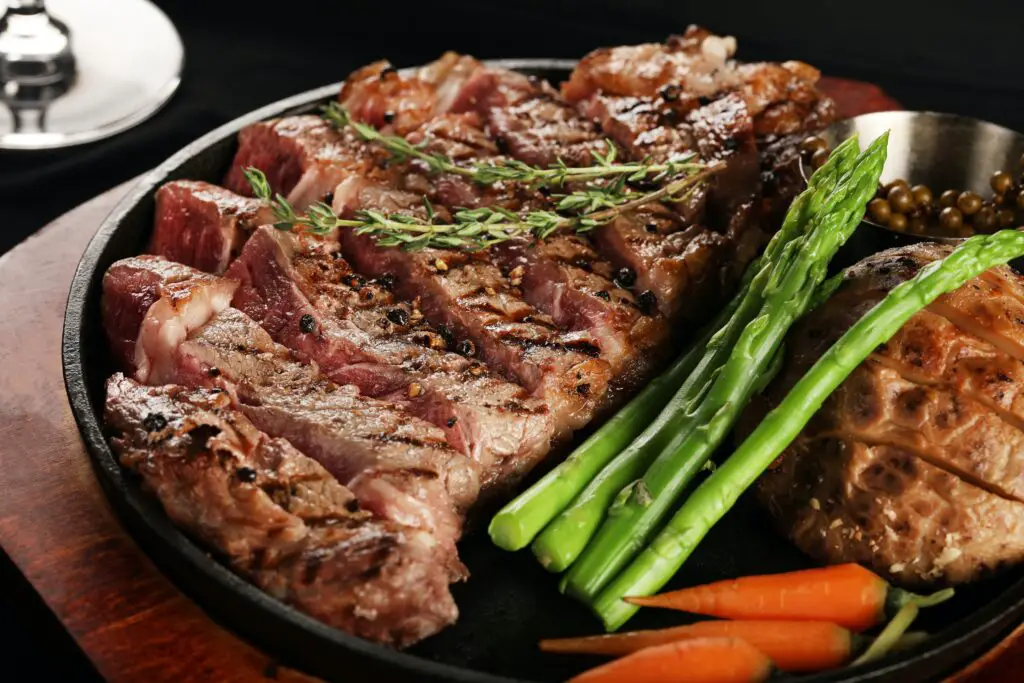If you’re on a low FODMAP diet, you may be wondering if it’s safe to eat beef. The answer is yes – beef is low FODMAP! However, there are a few things to keep in mind. In this blog post, we’ll discuss the low FODMAP status of beef and provide some tips on how to enjoy it while following a low FODMAP diet.
The low FODMAP status of beef
For those with irritable bowel syndrome (IBS), the diagnostic process is often a long and frustrating one. One of the first things that doctors will ask is whether you have any food intolerances. Food intolerance is different from a food allergy in that it does not involve the immune system. Instead, it is a reaction to certain components of food, such as carbohydrates, that the digestive system cannot break down properly. FODMAPs are a type of carbohydrate that is poorly absorbed by the intestines, and they are a common trigger for IBS symptoms. So, the question is, is beef low in FODMAP?
The answer is yes…and no. It depends on how the beef is prepared. If it is cooked in a tomato-based sauce, for example, then the sauce will add to the overall FODMAP content of the dish. However, if the beef is simply grilled or roasted, then it should be safe for those on a low FODMAP diet. The best way to be sure is to check with your doctor or a registered dietitian who can help you create a tailored eating plan that meets your specific needs.
Why beef is a good choice for a low FODMAP diet
If you’re following a low FODMAP diet, beef is a great protein choice. Beef is naturally low in FODMAPs, so you don’t need to worry about it triggering your symptoms. Plus, it’s a good source of nutrients like iron and vitamin B12.

There are a few things to keep in mind when buying beef for a low FODMAP diet. First, make sure to choose lean cuts of beef, such as sirloin or chuck roast. These cuts are lower in fat and calories and will be easier on your digestive system. Second, avoid processed beef products like sausage or pepperoni, as these often contain high levels of FODMAPs. Finally, if you’re cooking beef at home, be sure to cook it thoroughly. Undercooked beef can lead to food poisoning, which can trigger IBS symptoms.
If you follow these tips, you can enjoy beef as part of a healthy and delicious low FODMAP diet.
Tips for how to enjoy beef while following a low FODMAP diet
Is beef low fodmap? Yes, beef is a protein that is low in FODMAPs. This means that it is a good choice for people following a low FODMAP diet. Here are some tips for how to enjoy beef while following a low FODMAP diet:
- Choose lean cuts of beef, such as sirloin or tenderloin.
- Trim away any visible fat.
- Cut the beef into small pieces, so that it is easier to chew and digest.
- Cook the beef until it is well done. This will help to make it more tender and easier to digest.
- Serve the beef with other low FODMAP foods, such as vegetables, rice, or potatoes.
- Avoid eating large quantities of beef at one time. This can lead to digestive issues.
By following these tips, you can enjoy beef while following a low FODMAP diet.
The nutritional benefits of beef
Beef has long been a staple of the human diet, and for good reason. Not only is it delicious, but it is also packed with nutrients that are essential for human health. Beef is an excellent source of protein, which is essential for building and repairing tissues, as well as providing energy. Beef is also a good source of iron, which is necessary for carrying oxygen in the blood, and zinc, which is important for immunity and cell growth. In addition, beef contains vitamins B12 and B6, which are essential for metabolism and red blood cell production. While beef can be high in fat and cholesterol, leaner cuts of beef offer all the nutritional benefits without the extra calories. So next time you’re looking for a nutritious and delicious meal, reach for some beef.
The different types of beef available
Many types of beef are available to consumers in grocery stores, as anyone who has ever gone grocery shopping knows. For the most part, these differences can be categorized based on the part of the cow the beef comes from. The three most common types of beef are chuck, loin, and round. Chuck beef is a good choice for dishes that require longer cooking times, such as stews or pot roasts.

Loin beef is a leaner option that is well suited for grilling or frying. Round beef is also a leaner option, making it a good choice for those who are looking to reduce their fat intake. In addition to these three main types of beef, there is also ground beef, which is made from a mixture of chuck and loin cuts. No matter what your preferences are, there is sure to be a type of beef that meets your needs.
How to cook beef for a low FODMAP diet
For those with a sensitive stomach, the low FODMAP diet can be a godsend. This diet eliminates many of the common triggers for digestive distress, such as garlic and onions. However, this does not mean that you have to sacrifice flavor. There are still plenty of delicious recipes that you can enjoy on a low FODMAP diet. When it comes to beef, there are a few things to keep in mind.
First, opt for leaner cuts of meat, such as sirloin or tenderloin. These cuts have less fat, which can be difficult to digest. Second, be sure to cook the beef until it is well done. This will help to break down the tough fibers and make them easier to digest. Lastly, add some healthy fats, such as olive oil or avocado, to help lubricate the beef and make it easier to chew. By following these tips, you can enjoy delicious and nutritious beef dishes that are gentle on your stomach.
Challenges associated with eating beef on a low FODMAP diet
For those with a sensitive gut, the Low FODMAP diet can be a godsend. This diet eliminates foods that are high in fermentable carbohydrates, which can help to reduce symptoms of bloating, gas, and abdominal pain. However, for beef lovers, the Low FODMAP diet can pose some challenges. Many of the traditional methods of cooking beef—such as grilling or pan-frying—involve high heat, which can release FODMAPs from the meat.
In addition, many of the sauces and marinades used to add flavor to beef dishes contain garlic or onion, both of which are high in FODMAPs. As a result, it can be difficult to enjoy beef on a Low FODMAP diet. However, there are some ways to work around these challenges. One option is to cook beef using low-heat methods such as braising or stewing. Another is to use FODMAP-friendly seasonings such as herbs and spices to add flavor without triggering symptoms. With a little creativity, it is possible to enjoy beef even on a restrictive diet.
Interesting;
Are Brussel Sprouts Low FODMAP?
0